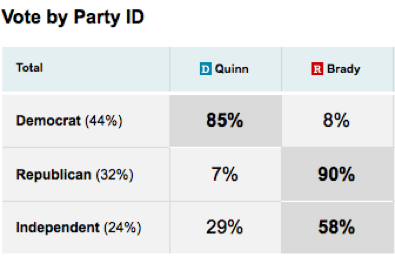
On the national level, the November 2nd midterm elections were historic. The Republicans gained at least 61 seats in the U.S. House of Representatives. It may rise to 64 or 65 seats when undecided races are finally decided. This is the largest shift in the House in a midterm election in nearly a century.
As for the 19 U.S. Congressional seats here in Illinois, Republicans are now in the majority, winning 11 of those seats. This includes incumbent wins by Peter Roskam (6th), Judy Biggert (13th), Timothy Johnson (15th), Don Manzullo (16th),Aaron Schock (18th), and John Shimkus (19th).
Adding to their ranks are 5 new Republicans, including Joe Walsh who upset incumbent Melissa Bean in the 8th; Robert Dold who prevailed over Dan Seals for the open seat in the 10th;Adam Kinzinger who trounced incumbent Debbie Halvorson in the 11th; Randy Hultgren who defeated incumbent Bill Foster in the 14th; and Bobby Schilling who won a surprise victory against incumbent Phil Hare in the 17th.
In the U.S. Senate, Republicans gained at least six seats — including Illinois’ liberal Republican Mark Kirk.
Voter unrest on display at tea parties and town halls for months foreshadowed victories in Congressional districts from coast to coast, in U.S. Senate contests from the Sunshine State through the Badger State, and in down ticket races across the country. As a result, Republicans now have 239 seats to the Democrats’ 187 in the U.S. House with 9 races yet to be determined.
That is the good news.
The picture in Springfield is considerably different. The so-called red “tsunami” that washed over that nation in the General Election barely created a puddle for the Illinois General Assembly.
In the Illinois State Senate the Democrats lost 2 incumbents. This will change the ratio to 35 Democrats and 24 Republicans. This might not seem like a lot, but it does remove the super majority that the Senate Democrats have enjoyed for the past two years.
In the Illinois State House, Republicans picked up 6 seats. This will change the ratio to 64 Democrats and 54 Republicans.
But perhaps the most consequential results of the 2010 General Election are Patrick Quinn’s apparent win for Governor and the retention of Thomas Kilbride to the Illinois State Supreme Court — which re-secures the Court’s balance of power for the Democrats (4-3). As a result, the Democrat Party of Illinois, specifically their leaders — Speaker Michael Madigan (D-Chicago), Senate President John Cullerton(D-Chicago), Governor Patrick Quinn (D-Chicago) and the Democratically controlled State Supreme Court –will have full control over drawing new legislative maps* for Illinois for the next decade. These new legislative districts will most certainly favor Democratic candidates and will inevitably lead to additional gains for Democrats in the years to come.
The picture may not be perfectly clear, but I can tell you that Illinois Family Institute and pro-life and pro-family advocates will have our work cut out for us at the state capitol for the foreseeable future.
*Redistricting happens every 10 years as a result of the Census population data. The U.S. Supreme Court requires that political districts be drawn to follow the constitutional mandate that provides equal weight to every person’s vote.






















